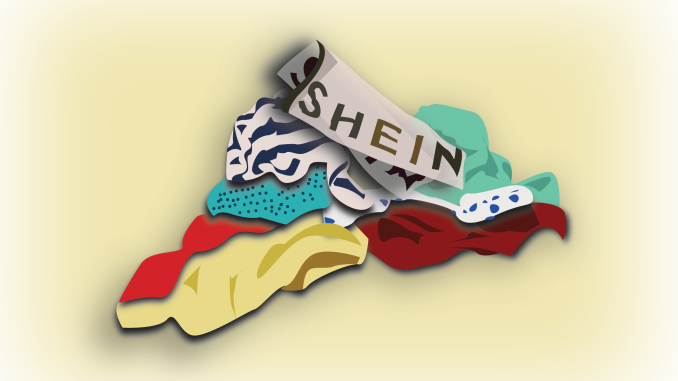
Corporate retailers, like Shein, Zara, and H&M, utilize cheap production — known as fast fashion — to keep pace with rapidly changing fashion trends. While its popularity and affordability have grown among college students, fast fashion is both environmentally and socially harmful.
It’s easy to fall victim to micro-trends as fashion is only popular for a short time and is constantly promoted by celebrities and social media influencers. Young adults now overconsume fast fashion by mass purchasing clothing, which the companies thrive on.
More than two in five college students buy clothes for events they’re likely to wear only once, Forbes reported. Because of these micro-trends, consumers say they’re addicted to fast fashion and college students would rather spend less on cheap clothes.
Students must stop to recognize the impacts of overconsuming fast fashion and transition to alternatives like thrifting and repurposing before rapidly buying clothes to follow the newest trend. Fast fashion isn’t worth sacrificing the environment and well-being of workers.
The average consumer now buys 60 percent more clothing than 15 years ago and each item is only kept for half as long, according to the UN Environment Programme. Clothes that are thrown out by consumers end up discarded in landfills, a major source of pollution to the environment. Fast fashion manufacturers often don’t follow their limited regulations because they are not heavily monitored, leading to poor working conditions like low wages, long hours, unsafe conditions and abuse.
Although college students are the biggest consumers of fast fashion, they aren’t entirely to blame for the environmental and social impacts. Students are targeted by companies who promote clothing through advertisements and trends, making their products seem like the better, more affordable option.
In 2022, the average working college student in Philadelphia will earn $3,856 per month, according to Zip Recruiter, and fast fashion is more affordable within that range.
Companies that produce fast fashion know that students don’t earn a lot of money, and they produce clothes that match trending college students’ styles, said Kira Eng, a sophomore gender, sexuality and women’s studies major.
“There’s a guilt to buying fast fashion, but a lot of people just do it anyway because we can’t afford other stuff,” Eng said.
Nevertheless, students struggling financially can look for clothes at thrift stores, which generally are more affordable and environmentally friendly.
The fashion industry is the second-largest water consumer, responsible for one-tenth of the water used to run factories and industries. It uses 20 percent of global wastewater and pollutes the ocean because many overseas retail factories don’t have strict environmental regulations, according to the Princeton Student Climate Initiative.
The vast majority of the clothes being produced are made from cotton, which is a great contributor to the excessive usage of water, said Kolson Schlosser, a geography and urban studies professor.
“Agriculture and growing commodity crops like cotton always have a tremendous environmental impact on the soil fertility, on the water quality, on the use of water, because cotton’s really water intensive.”
Beyond its environmental impacts, fast fashion negatively affects the people producing it. Many of the retailers are located outside the U.S. and use forced, child and underpaid labor to cheaply and rapidly produce clothing. Fast-paced production is prioritized more than the well-being of workers who are disregarded by the companies they unwillingly work for.
Another social impact of current trends is the pressure to constantly have new clothes, said Fletcher Chmara-Huff, a geography and urban studies professor.
“This whole consumption grind we’re on is not good, this whole idea that you should have new and more. More stuff does not equal happiness,” Chmara-Huff said.
College students should turn conversations about everyday fashion and buying new pieces into discussions about sustainable fashion practices, like shopping second-hand, donating and upcycling.
“The most sustainable option is always going to be what’s in your own closet,” said Elliza O’Grady, a junior advertising major and president of Thrift and Flop. “Before you buy a piece, think about how it would fit into your closet and how it will interact with your other pieces.”
It’s important to decide if buying a new article of clothing is the most necessary and ethical option. If the item doesn’t work well with your other clothes, it’s important to donate or upcycle it instead of throwing it away.
However, if a piece of clothing doesn’t fit properly or has worn out, upcycling — repurposing items to create a more usable piece — gives clothing another life. Thrift and Flop is a club and resource on campus that teaches upcycling to rework pieces already in students’ closets.
There are many thrift stores that will donate their proceeds to nonprofits and work with other organizations. Philly Aids Thrift is a store in Philadelphia where students can thrift and donate their unused clothing. Fabscrap is another resource that sells different types of fabrics that are second-hand collected so that customers can sustainably upcycle their own clothing.
Today, the Office of Sustainability is hosting a Pop-up Thrift on Polett Walk, where clothing donated during last year’s residence hall move-out will be sold for under $10.
It’s important that college students are mindful of their decisions when buying new clothing and handling their unused pieces, as it has a notable impact on the environment and society.



Be the first to comment